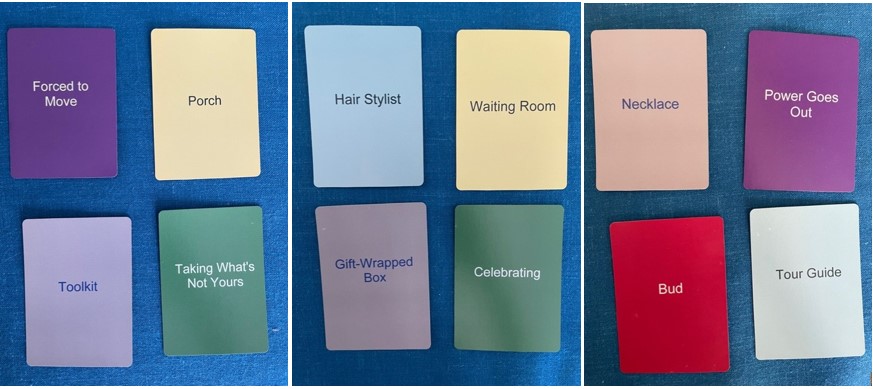Monday Miscellany - July 12, 2021
by Baltimore Review Staff Members
Starting today's Monday Miscellany with contributions from our Towson University interns, Bobby Jones, Stephanie Anderson, and Mandy Wolfe:
Do you outline when you write? Do you keep it close by? Do you strictly adhere to it, or do you find ways to break away from it? There’s a lot of talk in the writing sphere about what a writer’s outline should look like, how much time we should spend with it, and how much it really matters. Much like everything else about this craft, there are a million different ways to write and employ an outline, and no one way is correct.

Obviously, you should be doing whatever works best for you. Writers who use their detailed outlines religiously say it helps keep them focused and in the flow. Those who employ a looser outline enjoy the liberties given to them by the open nature of a relaxed set of rules. Both have their pros and cons; it’s just about finding what works best for how you write.
I personally like to find some middle ground between the two, depending on what kind of piece I’m writing. I’ll outline the general plot points and sequence of events, but the specifics are not fleshed out until I actually get there in the prose. I find that this helps me keep focused and push the story to where it needs to go; it also allows me to break out of my box and have fun with my story. Many times this leads to new “discoveries” in my stories—where I can push the plot in a direction I hadn’t originally planned! Finding new ways to make my story better as I’m writing it is fun and challenges me to create the best version of my story possible.
Consider your outlines more carefully the next time you write. Of course, you may not need one when submitting to us as we have a 5,000-word limit on fiction pieces, but for your longer works, stay cognizant of how you use your outlines. If something’s not working, changing it up may be the spark you need.
Some days, we’re on a roll. Everything falls into place, and the words are writing themselves. Then, a few hours later, the wellspring of inspiration seems to have entirely run dry. Like Paige Passantino in our June 28th Monday Miscellany, I’ve never liked the phrase “writer’s block.” I prefer to phrase it more as a writer’s pause, or a chance to take a breather and regroup, or to take time for yourself.

We hear a lot about “grind culture,” where people feel the need to maximize their own production. This could take the form of maintaining a constant social media presence, monetizing hobbies, or just plain overworking yourself. I have certainly had a deadly habit of pushing myself to the limit, and I can attest: overworking yourself, or creating unrealistically high expectations for your daily productivity, can lead to a nasty case of burnout.
Burnout is a direct descendant of “grind culture,” and I fear it’s something that we don’t talk about enough. Trying to push through burnout, rather than address it directly, can lead to feelings of increased aggression and isolation, and unconsciously foster negative associations with your craft that could create a blockade between you and writing. If you have a bad habit of overworking yourself in other areas of your life, finding time to write is going to be the last thing on your to-do list and the first thing to come off of it.
It’s okay to take time for yourself that doesn’t serve a productive end! It’s okay to watch a show, take a walk, or just decompress. It’s okay to take things off of your plate, and it’s okay to say no to obligations that will overwork you. You don’t need to feel guilty for living the life you are in! By giving yourself time to exist, you just might find that the will to write will come much easier, and feel less like something you need to make time for. If you want to dive in deeper with dismantling hyper-productivity, I would highly, highly recommend Jenny Odell’s How to Do Nothing: Resisting the Attention Economy, a text that examines our relationships with nature, each other, and ourselves.
It’s okay to opt-out of “grind culture,” and it’s okay to take a writer’s pause.
One way to enrich a story is to add diversity of language. Even though I do not speak French, if I have the urge to write a French character, I do a few things before succumbing to Google Translate. If a French person reads my story and is affronted by my attempt at their romantic tongue, I lose credibility and disparage the French. This is delicate territory. To respect the culture that you’re featuring in your work, conduct thorough research.

A human translator will always be more accurate than an online translator. If possible, ask a native speaker to help you translate or edit your translations. If you do want to use an online translator, there are better tools than Google Translate. Using an online dictionary will help translate words and expressions and provide conjugations, examples, and etymology. For simple translations, an online translator may do the trick. Try imTranslator instead of Google. This software compares the results with Google and Microsoft translators.
If you’re translating because a character speaks the language, it will almost always appear as dialogue. Do not include important plot points in the non-English dialogue. Instead, include emotions and reactions. Often, a reader will be able to pick up on the meaning of the dialogue even if there is not a translation present because of cognates, dialogue tags, and non-verbal descriptions. And since most readers have a smartphone nearby, there is less pressure on the writer to translate other languages in their works. However, don’t include long passages in a second language. A reader will likely skip over it. One sentence, though, is intriguing and digestible, and readers might decide to look it up themselves.
Even less than a full sentence is more common. Sprinkling in the second language is an easy way to remind your readers of your character’s culture without having to sift through the dictionary. Using expletives, or interjectory words or expressions, is a great way to do this. A Spanish-speaking character might say, “Basta! I don’t want to talk about it anymore.” Basta means enough in Spanish. It’s commonly used, and the reader doesn’t have to know the definition to understand the dialogue.
When I lived in Spain, I tried to use the English idiom “I’m on cloud nine.” Since it’s not an idiom in Spanish, it didn’t make sense. However, it was endearing and funny to the Spanish-speakers. Consider researching idioms and common phrases in the language you’re translating. Using a direct translation of an idiom demonstrates knowledge of the language and potentially adds humor. A bilingual reader will appreciate the extra steps the writer took to connect to their native language, and with context clues, a reader will understand the idiom without knowledge of the second language.
Similarly, I have a friend from Sweden that tells me he is sitting “in” the couch instead of “on” the couch. Researching a language’s prepositions and having a character make charming, inconsequential mistakes will have the same effect as translating idioms. Such mistakes are common for people speaking a second language, but an understanding of the language is required to execute this properly. Writing in broken English without knowledge of the character’s native language could create discomfort for bilingual readers.
Some fiction writers use italics for non-English words and phrases. However, this journal now leans toward the practice of not italicizing non-English words in most cases, for several reasons. Often, italicizing the words gives them an undue emphasis or unintended tone. Many non-English words, such as food names, are well known to many readers. Others will understand the words in context or can look them up. Italics can also be a distraction on the page, especially if particular words are used repeatedly on a single page, and distractions can keep a reader from being immersed in the world the writer has created. For further thoughts on italicizing non-English words in fiction, see this CMOS essay.

When I’m starting on a story, I often write a separate character sketch for each main character. I write it in flash fiction form (I’ve chosen 750 words or fewer) and work to make it crackle as I would a self-standing flash fiction piece. I always include physical description, character traits, a story arc, and tension. This actually helps coalesce the story line in my head when I sit down to compose a piece comprised of vibrant and interesting characters.
Expect to see the summer issue in about a week (or less). We can’t wait to announce the contest winners!
In the meantime—
Play Time!

Some people use Tarot cards. Too mysterious and complicated for you? Try making your own cards. Pick categories, like first names, occupations, objects, character traits, locations, situations, conflicts. Make up a bunch of them on 3X5 cards. Or get fancy like me and have them printed as card decks. (But really, 3X5 cards work fine.)
Pick some cards from however many categories you decide to use. I went with four each for the three sets below.
Freewrite, letting your imagination go its merry way. Or ask questions to get a firm grip on what you’ll be writing. Me—I like that sort of prep work. Like getting all the ingredients out on the kitchen counter before I start cooking.
For example, those cards on the left:
Forced to move: Who was forced to move? Why? Who else is involved here? What is the location?
Porch: What’s special about the porch? Is this the setting? The house they have to leave? Did something happen on the porch? What?
Toolkit: Who does the toolkit belong to? Is the toolkit connected to the porch? Could a tool be used as a weapon? Would the tools be used to repair something? Does this toolkit represent someone’s livelihood?
Taking What’s Not Yours: Are the people who are forced to move taking something from the house? Is someone taking something from the people who are forced to leave? What is taken? What are the consequences?
Try some questions with the other two sets of four cards. Or make your own cards.
Use what intrigues you. Throw the rest out. Whatever gets you going. There are no rules.

